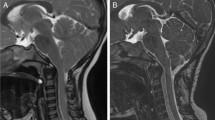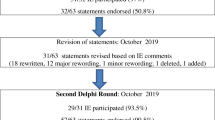Abstract
Introduction
The availability of magnetic resonance imaging (MRI) has resulted in an increasing number of asymptomatic, minimally symptomatic, and doubtfully symptomatic patients being diagnosed with a Chiari I malformation with or without syringomyelia. In an attempt to clarify how neurosurgeons manage these clinical problems, an international survey on the Chiari I malformation and related syringomyelia was undertaken.
Method
A questionnaire on the expected natural course of the disease and on aspects of the surgical technique for a number of hypothetical cases relating to Chiari I malformation with and without syringomyelia was used to survey Pediatric Neurosurgeons worldwide.
Results
Of 246 questionnaires distributed, 76 (30.8%) were completed and returned. There was a consensus that no operation should be carried out in asymptomatic patients with a Chiari I malformation, unless there is associated syringomyelia. There was a consensus that decompression of the Chiari malformation should be performed in patients with scoliosis when syringomyelia is present, and the majority decompressed the Chiari malformation in scoliotic patients even in the absence of syringomyelia. Suboccipital decompression was the standard surgical procedure for Chiari I malformations. The majority of respondents favored routine dural opening at surgery and closure with a pericranial or synthetic patch graft. In the case of a persistent or progressive syrinx after suboccipital decompression, the majority recommended shunting of the syrinx to the subarachnoid space or to the pleural cavity.
Conclusion
There continues to be much variation in the management of the Chiari I malformation.












Similar content being viewed by others
References
Batzdorf U (1988) Chiari I malformation with syringomyelia. J Neurosurg 68:726–730
Batzdorf U (1996) Syringomyelia, Chiari malformation and hydromyelia. In: Youmans J (ed) Neurological surgery, 4th edn. Saunders, Philadelphia
Batzdorf U (2001) Comment. Neurosurgery 48:228
Batzdorf U, Klekamp J, Johnson JP (1984) A critical appraisal of syrinx cavity shunting procedures. J Neurosurg 61:531–538
Bejjani GK (2001) Definition of the adult Chiari malformation: a brief historical overview. Neurosurg Focus 11, article 1
Duddy JM, Williams B (1991) Hindbrain migration after decompression for hindbrain hernia: a quantitative assessment. Br J Neurosurg 5:141–152
Dyste GN, Menezes AH, VanGilder JC (1989) Symptomatic Chiari malformations. An analysis of presentation, management, and long-term outcome. J Neurosurg 71:159–168
Feldstein NA, Choudhari TF (1999) Management of Chiari I malformations with holocord syringo-hydromyelia. Pediatr Neurosurg 31:143–149
Fischer EG (1985) Posterior fossa decompression for Chiari I deformity, including resection of the cerebellar tonsils. Childs Nerv Syst 11:625–629
Gambardella G, Caruso G, Caffo M, Germanò A, La Rosa G, Tomasello F (1998) Transverse microincisions of the outer layer of the dura mater combined with foramen magnum decompression as a treatment for syringomyelia with Chiari malformation. Acta Neurochir (Wien) 140:134–139
Hanieh A, Sutherland A, Foster B, Cundy P (2000) Syringomyelia in children with primary scoliosis. Childs Nerv Syst 16:200–202
Haroun RI, Guarnieri M, Meadow JJ, Kraut M, Carson B (2000) Current opinions for the treatment of syringomyelia and Chiari malformations: survey of the Pediatric Section of the American Association of Neurological Surgeons. Pediatr Neurosurg 33:311–317
Hida T, Sasaki H, Takamura H, Kobayashi N (1993) Foramen magnum decompression with removal of the outer layer of the dura as a treatment for syringomyelia occurring with Chiari I malformations. Neurosurgery 33:845–849
Iwasaki Y, Hida K, Abe H, Koyanagi I (1997) Etiology and treatment of syringomyelia. Neurosurgeons 16:108–112
Iwasaki Y, Hida K, Koyanagi I, Abe H (2000) Reevaluation of syringosubarachnoid shunt for syringomyelia with Chiari malformation. Neurosurgery 46:407–413
James HE, Brant A (2002) Treatment of the Chiari malformation with bone decompression without durotomy in children and young adults. Childs Nerv Syst 18:202–206
Koyanagi I, Iwasaki Y, Ysu T, Akino M, Abe H, Ikota T, Mitsumori K (1991) Surgical treatment of syringomyelia with Chiari malformation. Effect of foramen magnum decompression. Spinal Surg (Tokyo) 5:43–49
Krieger MD, McComb JG, Levy ML (1999) Towards a simpler surgical management of Chiari I malformation in pediatric population. Pediatr Neurosurg 30:113–121
Matsumoto T, Symon S (1989) Surgical management of syringomyelia. Surg Neurol 32:258–265
Milhorat TH (1993) Comment. Neurosurgery 33:849–850
Milhorat TM (2000) Comment. Neurosurgery 46:412
Nishizawa S, Yokoyama T, Yokota N, Tokuyama T, Ohta S (2001) Incidentally identified syringomyelia associated with Chiari I malformations: is early interventional surgery necessary? Neurosurgery 49:637–641
Parizek J, Sercl M, Michl A, Mericka P, Nemecek S, Nemeckova J, Jakubec J (1994) Posterior fossa duraplasty in children: remarks on surgery and clinical and CT following. Childs Nerv Syst 10:444–449
Park JK, Gleason PL, Madsen JR, Goumnerova LC, Scott RM (1997) Presentation and management of Chiari I malformation in children. Pediatr Neurosurg 26:190–196
Sahuquillo J, Rubio E, Poca MA, Rovira A, Rodriguez-Baeza A, Cervera C (1994) Posterior fossa reconstruction: a surgical technique for the treatment of Chiari I malformation and Chiari I/syringomyelia complex. Preliminary results and magnetic resonance imaging quantitative assessment of hindbrain migration. Neurosurgery 35:874–885
Samii M (1998) Comment. Acta Neurochir (Wien) 140:139
Williams B (1993) Surgery for hindbrain related syringomyelia. In: Symon L et al (eds) Advances and technical standards in neurosurgery. Springer, New York Berlin Heidelberg
Acknowledgements
We wish to thank those who completed the questionnaire survey: I.R. Abbott, J.M. Abdullah, D. Adelson, V. Balakrishnan, L.T. Basauri, M. Besser, R. Boop, W. Butler, M. Caldarelli, J. Cappelen, S. Constantini, E.M.J. Cornips, A. Czorni, P. Dhellemmes, M.S. Dias, B. Due-Tonnessen, M. Edwards, R.G. Ellenbogen, E. Erdogan, J.P. Farmer, S. Glazier, J.H. Guajardo Torres, S. Haines, A. Hanieh, R. Hayward, M.D. Heafner, E. Helseth, E.J. Herrera, R. Hollenberg, S.K. Hwang, M.A. Ibáñez, Indianapolis Neurosurgery, B.A. Kaufman, Y. Kushel, J.R.S. Leggate, J.F. Martinez-Lage, P.L. May, C. Mazza, J.G. McComb, M. Medlock, G. Meyer, N. Morota, A. Murgio, J. Nadell, M. Panigrahi, A.D. Parent, M. Partington, J.C. Peter, G. Pinna, H. Portnoy, J. Punt, A.G. Ramírez Reyes, H.L. Rekate, P. Richards, A.M. Ritter, F. Rueda Franco, H. Sakamoto, S.K. Sankhla, M. Scott, S. Sgouros, H.J. Shin, M. Shinoda, The Montreal Children’s Hospital Neurosurgery Division, T. Tomita, T. Tsuchida, F. Van Calenbergh, S. Valenzuela, W.P. Vandertop, P. van Ouwerkerk, M. Vassilyadi, E.C.G. Ventureyra, J.H.C. Voormolen, M. Vural, M.L. Walker, K.C. Wang, M. Yamasaki, Y. Yoshida, M. Zerah, G. Zuccaro.
Author information
Authors and Affiliations
Corresponding author
Rights and permissions
About this article
Cite this article
Schijman, E., Steinbok, P. International survey on the management of Chiari I malformation and syringomyelia. Childs Nerv Syst 20, 341–348 (2004). https://doi.org/10.1007/s00381-003-0882-2
Received:
Published:
Issue Date:
DOI: https://doi.org/10.1007/s00381-003-0882-2




